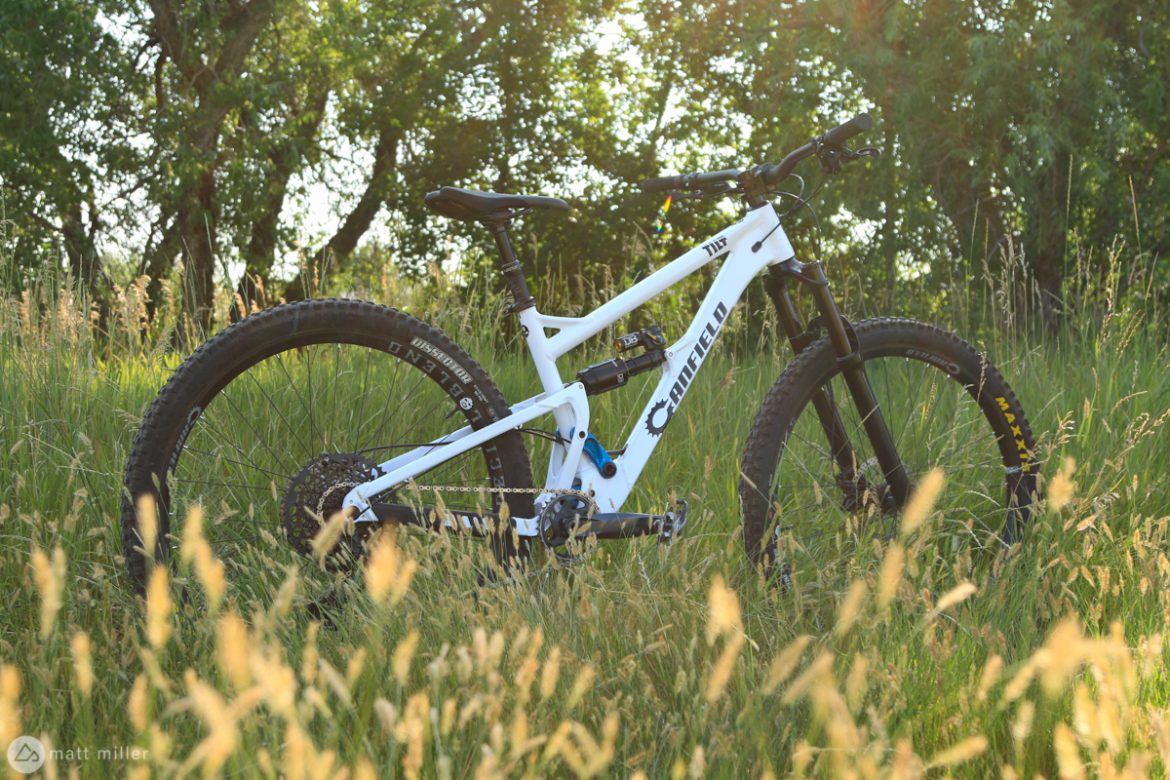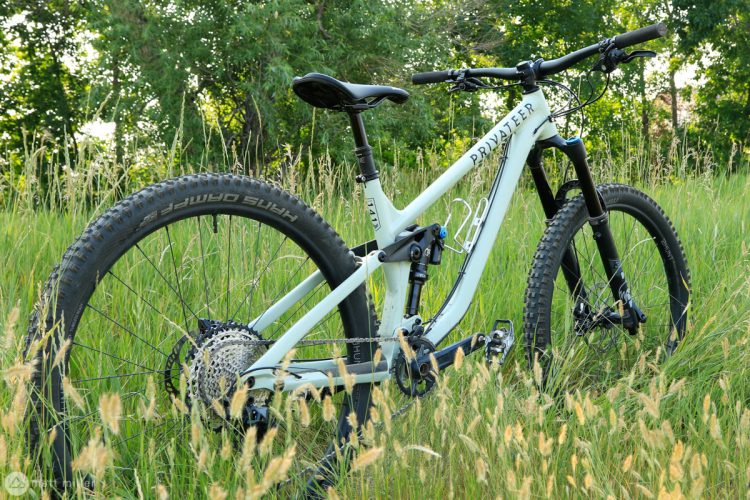Check out the 2021 Singletracks Mid-Travel Mashup reviews on Singletracks and video reviews on our YouTube channel.
The Canfield renaissance is one any core mountain biker can appreciate. For people who enjoy supporting small companies who make great stuff, seeing Canfield rolling out new bikes again should make them smile. The cold, stout feel of the aluminum tubing, and anodized suspension links evoke a different sense than glazing over the latest sleek carbon wondership of big bike shops. The Tilt feels more unique, which makes it a little more personal.

Canfield Tilt
- Price: Frame $2,499
- Buy from Canfield and Worldwide Cyclery
Canfield released the Tilt and Lithium toward the end of 2020, and the brand has been filling out its stable since. The Tilt is a 138mm-travel 29er that can be paired with either a 140 or 150mm fork. The trail bike is built with descending in mind, on par with the Canfield namesake, though it climbs excellently. More on that later. Climbing and descending both feel great on the bike in large part due to the Canfield Balance Formula suspension.
Geometry

Geometry on our medium Canfield Tilt started with a 450mm reach, adding or subtracting 25mm up or down the size chart. Standover height on the trail 29er is low at 730mm, and the wheelbase feels on par at 1,198mm. The head tube angle is 65°, the STA is 77°, and the chainstay length across all sizes is a stubby 425mm.
All of this is to say that it feels like a modern, aggressive trail bike, made to be stable, capable, and maneuverable; traits which are all coveted on a mid-travel trail bike.
Build kit

Canfield chose some very nice componentry on this rig, which feels pretty unique compared to a lot of other frames out there. Our test bike, valued at $4,900, came with Cane Creek suspension front and rear—a Kitsuma DB air shock and a Helm MKII fork. Both are highly adjustable and ready to make this unique bike even more personalized under the rider.
Our testers for this bike are Matt Miller (rider profile below) and Chris Schieffer.
Reviewer profile height: 173cm (5’8″) weight: 75kg (170lb) testing zone: Colorado Front Range
We had TRP Slate T4 brakes, and Canfield rims laced to Spank hubs. The cockpit includes an SDG dropper post, and a ProTaper 40mm stem, with an 810mm-wide set of ProTaper bars. The Tilt also gets a Maxxis Minion DHF up front, a Dissector in the rear, and a SRAM GX Eagle drivetrain with 165mm-long crank arms. Why that short? In a nutshell, the leverage shouldn’t matter for mountain biking as much as it does for road, and riders can skip over more pedal strikes and accelerate more easily.
Climbing

Climbing is a special ordeal on the Tilt for a few reasons. For a trail bike made from alloy with a skull on the head tube, there’s a lot to say about how this bike tackles ascents. Our size medium weighed just under 32lbs, so it’s not the lightest climber in our mashup of trail bikes. But, with the CBF suspension, short cranks, and an excellent seat tube angle, the Tilt was a favorite of our testers for climbing chunky Colorado singletrack.
We marveled at how effortlessly the Tilt rolled through messy rock gardens. The CBF suspension gives endless traction and predictability. You know those sections of a climb where it feels like you just need to throw a foot down and start over? You still have that feeling occasionally on the Tilt, but ultimately, your foot can stay on the pedals more often.
The CBF suspension feels supportive in these situations, keeping the rider up high, and the tire stays planted to the ground. Coupled with the shorter crank arms, when you do feel like you’re about to stall out in these situations, the 165mm arms spin the bike up to speed again easily to get you moving. In short, the Tilt feels awesome clawing up technical climbs.
And then there’s the supportive and peppy nature of the CBF that, paired with the 77° seat tube angle, feels just as homey on sustained smooth climbs. Sure, you could throw some carbon hoops on here and make an even snappier, more efficient climber out of this bike, but just about anyone should be stoked on how the Tilt climbs.
Descending

With just a hair less than 140mm of rear travel, the Tilt is no monster truck. It’s a capable bike, but not a trail plow. That said, it’s fun and capable on just about anything. We felt that we needed to maintain an aggressive, forward posture on the descents and really put some oomph into the frame to get the most out of the Tilt on the descents, but given its short rear end, it’s an easy bike to whip around corners.
With the extra heft of the alloy frame, the Tilt felt stable through the air, and the supportive suspension made it easy to preload this bike into a takeoff.
Considering the frame material, the burly-looking linkage, and Canfield’s appetite for gravity, the Tilt met our expectations for descending, and surpassed them a bit with its agility. While some brands are growing their chainstays after shortening them for so long because stability became an issue, the 425mm stays on the Tilt feel like nothing but a positive.
Again, we should highlight the CBF suspension, because that’s a big part of any Canfield full-suspension rig. The rear wheel on this Tilt gets out of the way so easily, and it’s easy to pick up and maintain speed through really chunky trail. Touching down off of jumps and drops, the Tilt’s rear end feels progressive, but confident, and we never suffered a harsh bottom out.
Component check

Almost everything worked well on the Tilt for us. We like the TRP Slate T4s, which make a solid trail bike brake that’s markedly different than the two big competitors.
The Cane Creek suspension feels marvelous, and though it may take some time to dial in, the bigger dials on the new Kitsuma shock make it feel slightly more approachable compared to the tiny hex bolts on the previous generation where users may have been deterred from tuning.


The short crank arms were something of significance as well, and likely contributed to how well this bike tackled technical ascents.
The wide bars, however, at 810mm, frightened our collective knuckles several times over. Even some long-legged enduro bikes we’ve seen lately have had 780mm wide bars out of the box, and that feels like a perfect width for this bike too. This might have been a COVID-induced supply issue though, and they’ll be easy to trim for riders who don’t like the width.

Lastly, we found that the Tilt, in its printer-paper-white paint could be a little polarizing. It might be the lack of any sort of hue, or it might be the Canfield font across the downtube, but people were either really excited about the look or they hated it. We got used to it the more we rode the bike, and appreciate that it adds some more distinction. It’s definitely different than most of the market’s offerings.
Wait. One more thing. We can’t get around the fact that there is no space inside the front triangle for a water bottle. The mounts are on the underside of the down tube, which is certainly a bit of a bummer.
Pros and cons of the Canfield Tilt trail bike
Pros
- Amazing suspension platform that feels great over ledgy, chunky terrain
- Unique brand and appearance
- A good value considering the components
Cons
- No bottle mounts inside frame
- Looks might be divisive for some
- Only one build option

Closing thoughts
The Canfield Tilt is not for everyone. Some won’t like the aesthetic, others won’t regard it, and will flock to something more plastic, svelter, with more hype. Those people are missing out on a truly unique and very well-rounded trail bike.
The Tilt is a great climber, and an absolute blast on the descents, but riders who have some technical trails close to them will love it most. You can take the Tilt on loads of flow trails if you like, but you’ll miss out on the true magic of the CBF suspension platform.
Thus, riders who appreciate great bikes from a small brand, and want something that’s going to shine on the ups and downs are going to love this trail bike.
- Price: Frame $2,499
- Buy from Worldwide Cyclery
Show your Support
Become a Singletracks Pro Supporter today and enjoy benefits like ad-free browsing.
With your support we can provide free worldwide trail information and original content created by our team of independent journalists.



















0 Comments